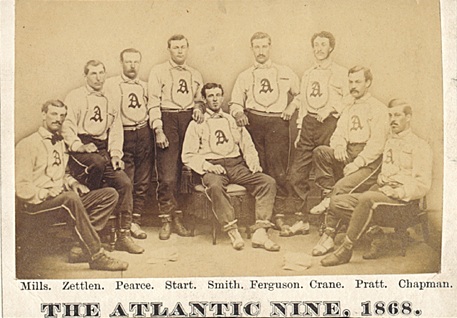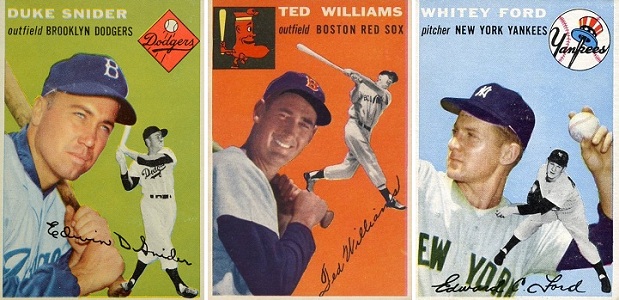(This is the first of a two-part series)
Yesterday I spent some quality time with myself organizing and cataloging my latest Clayton Kershaw and Matt Kemp baseball cards. Today, I will take my Duke Snider cards out of a shoe box and place them in order, by year, in a binder. Imagine that! Duke Snider cards in a shoe box, the traditional storage place for baseball cards.
While cataloging my 2012 cards yesterday, two opposing tracks caught my attention. First, I was instantly transported back to the future experiencing my first contact with baseball cards. I could almost smell the bubble gum, feel the white powder that kept if from sticking to the cards, and I could see the cards, the 1954 Duke Snider, Ted Williams and Whitey Ford. I can recall putting cards on our bicycle spokes, those of players in whom we were not interested, like Ted Kluszewski – a felony offense by today’s standards. Oh, if only I had known.
The second thing that peaked my interest yesterday was that all of the 2011 and 2012 cards were Topps cards, with the exception of six with a Bowman label. A quick check on the back of those cards revealed Bowman is registered under the Topps name. Oh yes, there was one lone Panini card. At one time the market was flooded by cards from a number of distributors: Topps, Bowman, Fleer, Donruss, Sportflics, Leaf, Upper Deck, Score. The observation regarding Topps caused me to check it out. Is the baseball card industry still flourishing?
My research sidetracked me and this post a bit (actually a lot) and led me to some of the interesting history of baseball cards and the influence they have had in North America, particularly in the United States – not only on individuals but also on the game and the economy as well. Sources point to 1868 as the birth date of baseball cards. Ironically, the baseball card (or other advertisement) was secondary and used to attract buyers of the actual product – the bubble gum. Peck and Snyder, a sporting goods store in New York, began producing ‘trade cards,’ not called trading cards then, featuring baseball teams in 1868. The cards were a natural vehicle for advertising. The connection between baseball teams and sporting goods was obvious, with a team image on the front and advertising on the back. Not only that, people bought the advertising. That little piece of cardboard has had a 144 year run, beginning at least forty years before any of the other major sports.

The Trade Cards distributed by Peck and Snyder are generally regarded as the first baseball cards. They were the first ‘mass produced’ advertising cards with a baseball theme. Peck and Snyder was a manufacturer of baseball equipment, and their cards featured prominent teams of the day. They are the size and style of a Carte de Viste with a paper team photograph pasted to a cardboard mount. The backs can be found with advertisement for Peck and Snyder, other companies, or are blank.
The baseball card industry, in its long history, has had a series of peaks and valleys. It played a significant part in the Great Depression for at least two industries, gum and candy makers. While we were playing with baseball cards as kids in the 1960’s, the royalties from those cards helped transform the baseball players association into one of the country’s most powerful unions. What a change that has made in the game. Some will argue for the better, while others disagree. As the royalties from those cards grew, so did the strength of the players union. Baseball cards are far from the sole source of the growth of the union but very significant at the time.
I would argue that the golden age of baseball cards was in the fifties. That most likely is simply because I was introduced to them at that time, probably in 1953. I learned that Jackie, Campy, Newk, Jim Gilliam, Joe Black were black ball players. That made no difference to me. They were ball players and more importantly, Dodgers. I imprinted on the Dodger logo like a newly hatched chicken. The 1954 Duke Snider card is my absolute favorite all time card.
The baseball card industry would cite the 1980’s and 1990’s as its golden age. That is, an age of gold, as in money in the bank, not gold as a Duke Snider card in a kid’s hand. The business, blossomed and flourished going through a spectacular growth bubble. It became a billion dollar a year industry. Thus was the rise of the baseball card industry from a lowly advertising tool in 1868 to an industry of which everyone wanted a part in the last two decades of the twentieth century. The story goes on, but on another day.




 December 15th, 2012 at 12:04 am
December 15th, 2012 at 12:04 am  by Harold Uhlman
by Harold Uhlman 
 Posted in
Posted in 

Another GREAT “I didn’t know that” story, Harold – Thanks!
Hard to believe that this 1909 Honus Wagner card sold for $2.8 million in 2008.
It was once owned by Wayne Gretzky, who bought it in 1991 for $451,000 and sold it 1995 for $500,000. (He should have waited to sell it another 13 years).
Don’t let “Pickles” the dog anywhere near this card!
I don’t believe, at least in Brooklyn, that the baseball card was a popular as it is today, back in the 50s. Not in the sense of whose picture was on it.
At least in my neighborhood, the way cards where used mostly was to “Flip” and play heads or tails or matching.
There’s a good chance, however, that some people were smart enough to hold on and treasure them as you did, BD.
I remember saving some “Dodger cards” and stupidly cutting the player out of the cards and pasting them in a scrap book, which I think I still have. I regret that now, but never thought of that then.
It’s great to read about the way you’ve saved yours and I bet you’ll never regret it.
Actually OBF, part 2 will reveal I didn’t keep my cards. I had to start again.
I totally appreciate your interest in the cards even though I never collected. I enjoyed Part I and look forward to upcoming parts. Jim, however, is the almost-classic story. He had every card in the 50’s and multiples of most. Of course they were stored in shoe boxes. But instead of his mother throwing them out like happened to so many, his burned in a fire. Oh to have them back…
Harold, great article! I remember buying cards in the late ’50s and early ’60s. I had all the greats Koufax, Drysdale, Mays, Mantle, etc. I never saved any of mine either. My mother would convince me to throw them out at the end of each baseball season by telling me that I’ll get new ones next year. So, like yourself I had to start again with my collection. In the last few years I’ve lost interest in it and haven’t kept it up. I look forward to talking to you about it during ST.
[…] articles: Requiem for the 00s: The Decline of Topps Baseball Cards – SBNation.com The Rise and Fall of Baseball Cards: Part-1 – The Rise | Think Blue LA The Rise and Fall of Baseball Cards: Part-2 – The Fall | Think Blue LA The Baseball Card […]
carnival breeze deck plans
The Rise and Fall of Baseball Cards: Part-1 – The Rise | Think Blue LA
K-N
The Rise and Fall of Baseball Cards: Part-1 – The Rise | Think Blue LA